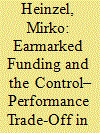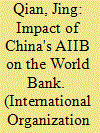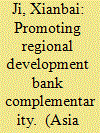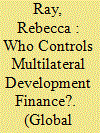|
|
|
Sort Order |
|
|
|
Items / Page
|
|
|
|
|
|
|
| Srl | Item |
| 1 |
ID:
191918


|
|
|
|
|
| Summary/Abstract |
Since the 1990s, the funding of multilateral development assistance has rapidly transformed. Donors increasingly constrain the discretion of international development organizations (IDOs) through earmarked funding, which limits the purposes for which a donor's funds can be used. The consequences of this development for IDOs’ operational performance are insufficiently understood. We hypothesize that increases in administrative burdens due to earmarked funding reduce the performance of IDO projects. The additional reporting required of IDOs by earmarked funds, while designed to enhance accountability, ultimately increases IDOs’ supervision costs and weakens their performance. We first test these hypotheses with data on project costs and performance of World Bank projects using both ordinary-least-squares and instrumental-variable analyses. We then probe the generalizability of those findings to other organizations by extending our analysis to four other IDOs: the African Development Bank (AfDB), Asian Development Bank (ADB), Caribbean Development Bank (CDB), and International Fund for Agricultural Development (IFAD). Using data on the performance of 7,571 projects approved between 1990 and 2020, we find that earmarked funding undermines both cost-effectiveness and project performance across IDOs. Donors seeking value for money may consider allocating more money to core funds rather than to earmarked funds.
|
|
|
|
|
|
|
|
|
|
|
|
|
|
|
|
| 2 |
ID:
191910


|
|
|
|
|
| Summary/Abstract |
The World Bank, under the stewardship of the United States, stands out as the global leader among international development organizations. Does China's establishment of the Asian Infrastructure Investment Bank (AIIB) undermine this status? Examining this question, we focus on the borrowing practices of a special set of countries: the founding members of the AIIB. These founders openly defied the public preference of the United States, arguably to create a potential rival to the World Bank. Using a new causal inference method, Pang, Liu, and Xu's Dynamic Multilevel Latent Factor Model—as well as several well-known estimation models as robustness checks—we document at least a temporary decrease in the number of World Bank infrastructure projects that the developing AIIB founders have entered into. This study presents the first systematic evidence that China's AIIB could unsettle the political influence the United States has enjoyed over developing countries through its leadership of the World Bank. An important set of countries may be parting ways with the World Bank and looking to a Chinese institution for leadership in the world of development.
|
|
|
|
|
|
|
|
|
|
|
|
|
|
|
|
| 3 |
ID:
185233


|
|
|
|
|
| Summary/Abstract |
The contemporary US/Japan-Chinese rivalry and tension around dam building in the Mekong region is often mistakenly seen as the US and Japan’s reactive response to recently growing Chinese diplomatic and economic influence in the region. In fact, the United States and Japan have been critical architects of institutional and financial engineering for hydropower development in the Mekong region, which predates involvement by the People’s Republic of China (PRC). The factors and dynamics involved in significant lending regime shifts away from a liberal hydropower finance regime to an export credit driven model premised on Asian economic statecraft is an understudied topic. This article fills part of this gap through a case study of evolving hydro-financing regimes in Lao PDR from the 1970s to the present. The study draws on extensive ethnographic work in Laos, Japan, Thailand, and the United States with local and external political elites, hydro-financing technocrats, and business actors and gains additional insights from analysis of primary firm, institutional, and government documents. The article finds that the role of economic crises and their impact on the relative economic power of hydropower financing regimes as well as their ideational impact on borrower regimes are significant in explaining shifting patterns in lending regime dominance.
|
|
|
|
|
|
|
|
|
|
|
|
|
|
|
|
| 4 |
ID:
154429


|
|
|
|
|
| Summary/Abstract |
As the international development finance architecture decentralises, a plethora of regional multilateral development banks (MDBs) emerge. The institutional landscape in Asia is transforming with the establishment of the Asian Infrastructure Investment Bank (AIIB). This paper aims to shed light on the horizontal relationship between the traditional development actor, the Asian Development Bank (ADB), and the nascent AIIB. Based on the collaborative experiences of the European Investment Bank (EIB) and the European Bank for Reconstruction and Development (EBRD), this article recommends that ADB and the AIIB should form tri-partite coordination mechanism to promote cooperation, develop complementary portfolios in terms of sectoral exposure and geographical coverage and co-fund projects to catalyse greater inter-agency cooperation. The resulting synergies will stitch the two institutions into an interdependent and coherent development finance structure in Asia and beyond.
|
|
|
|
|
|
|
|
|
|
|
|
|
|
|
|
| 5 |
ID:
184646


|
|
|
|
|
| Summary/Abstract |
Multilateral development banks (MDB s) are a growing source of development finance, with nearly two trillion dollars in assets. They have developed a wide array of governance structures, with implications for the distribution of members’ control over those assets. This paper measures that power distribution in 28 MDB s using Penrose-Banzhaf and Shapley-Shubik power indices and members’ relative voting power on MDB governance boards. It uses these calculations to create a typology of MDB governance structures: creditor-led MDB s distribute power among non-borrowers, core borrower-led MDB s distribute power among a few central borrowers, and mutual aid-oriented MDB s distribute power among a wide group of borrowers. Finally, it explores the impact of the creation of two new MDB s, the Asian Infrastructure Investment Bank and the New Development Bank, and finds that while they do not dramatically alter the global landscape they do allow significantly greater access to capital for some borrowers.
|
|
|
|
|
|
|
|
|
|
|
|
|
|
|
|
|
|
|
|
|